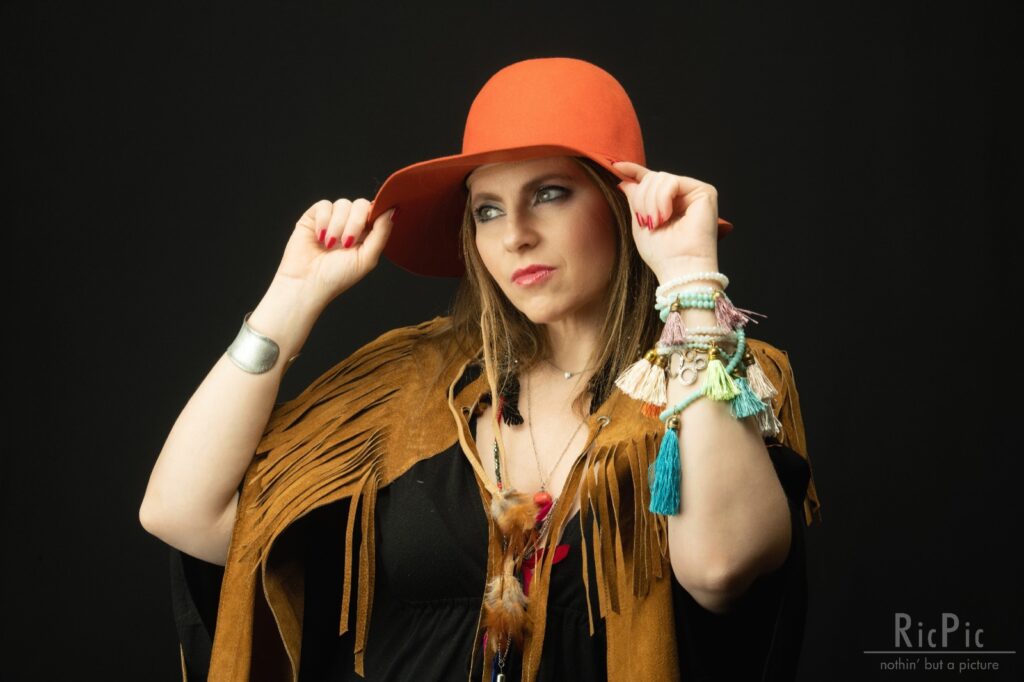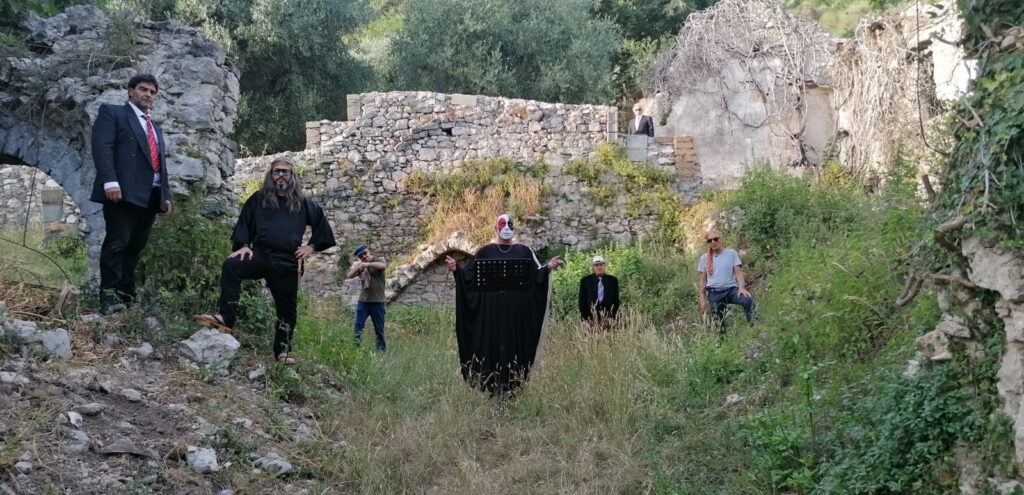
Here speaks the director of an highly acclaimed documentary, “Milano calibro 9: Le ore del destino”, in competition at the third edition of the Indiecinema Film Festival
Thursday 27 June 2024 (8.30 pm) Indiecinema Film Festival will return to the Circolo Arcobaleno in Rome, the main venue of the autarchic cinematographic event, with a tribute to M. Deborah Farina, whose documentary Milano calibro 9: Le ore del destino is in competition at the third edition of the festival.
We took the opportunity to delve deeper and carefully analyze the inspiration that led the author to create this work, talking about it directly with her!
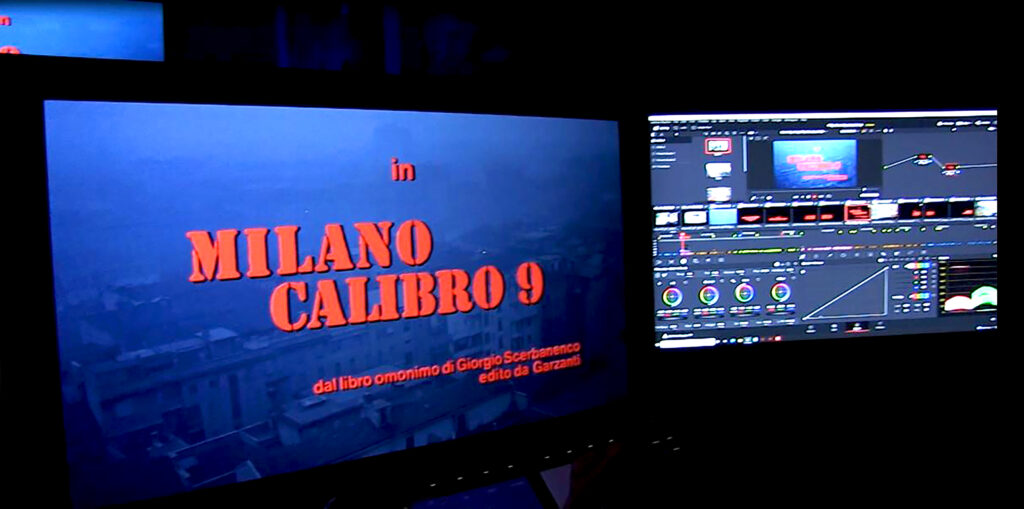
Milano calibro 9: the passion’s birth
A documentary like “Milan calibro 9: Le ore del destino” is a whole mine of suggestions. And it could be approached from multiple points of view. Trying to be philological, however, when and how did your love for Fernando Di Leo’s cinema begin? And has this passion already been at the center of your other works?
My passion for Fernando Di Leo‘s cinema was born in unsuspecting times, when, despite my training as a scholar of independent American cinema linked to experimentalism and underground coast to coast, I began to delve into it, not only as ‘entertainment’ , genre cinema: noir, thriller, detective story, Italian detective story in particular. Of all this incredible production, the film that literally shocked me was Milano calibro 9. The total fascination for this cult film from 1972 and for its thrilling soundtrack by Luis Bacalov and Osanna, its viewing and listening, is always alive is present; despite having definitely explored every text and subtext, dismantled, reworked, I still find different ideas, unexplored territories, as if it were the first time every time. I have to thank Domenico Monetti and Luca Pallanch (Csc/CinetecaNazionale), who, after the good result of Anarchitaly. Cinema espanso e underground italiano 1960-1978, created with their collaboration alongside Enrico Magrelli and thanks to the support of Marco Muller, artistic director of the 68th Venice Film Festival, from which the retrospective in question came, they asked me if I wanted to continue the collaboration, creating, starting from 2013, the homage documentary for the ten years since the death of Fernando Di Leo. From there was born Down by Di Leo. Viaggio d’amore alla scoperta di Fernando Di Leo, which tells the entire artistic and private story of the Maestro. In 2022, again thanks to the collaboration with the Csc/Cineteca Nazionale, I was involved in the creation of the documentary on the fiftieth anniversary of Milano Calibro 9 (Milano calibro 9: Le ore del destino), honored with the wonderful restoration of the film by the digital laboratory of the Cineteca Nazionale (in collaboration with Minerva Pictures), headed by Sergio Bruno, assisted by Marco Meconi and all the staff. The journey of love to discover the cinema of Fernando Di Leo, exemplified in the final scene of Down by Di Leo (Ursula Andress who flies away on a plane towards an unknown destination next to Marc Porel, from “Colpo in cane”, making a wink at the audience as if to say ‘to be continued‘), goes on.
We remember the premiere of the documentary at the Turin Film Festival 2022, a screening which took place on the fiftieth anniversary of “Milano calibro 9” and in conjunction with the presentation of the meticulous restoration which this film underwent and which you mentioned earlier… not by chance in your film the complex operation we are talking about emerges through the testimonies of those who dealt with it, within the Cineteca Nazionale. This accurate reconstruction is really very interesting, how did you relate to them so that in an overall short amount of time the entire issue was explored so well?
The fantastic premiere of the restoration and the documentary, sold out at the 40.Torino Film Festival, (Artistic Director Steve Della Casa)with the protagonists of both the film and the documentary (Barbara Bouchet, Lino Vairetti, Davide Pulici, Sergio Bruno), was a moment of great shared joy, after all the work done around the film. A complex operation which, with “Le ore del destino“, had to tell in a form between the narrative, the experimental, the direct cinema at the basis of my cinematographic works, what Milano calibro 9 is, its genesis, its rise, its sources, giving a tight editing rhythm, alongside the lyrical openings that I entrusted to Osanna‘s musical performances, as fictional scenes between one level of the narrative and another. The search for the material and its re-elaboration in a continuous reference between the past and the present, the fundamental historical and critical leitmotif of Davide Pulici, the use of Scerbanenco‘s phrases, chosen from the monumental correspondence of his noir literary works, entrusted to the voice of Renato De Rienzo, alongside pure documentary filmmaking to describe the phases of the restoration, they have created a world, a story to return to the public.
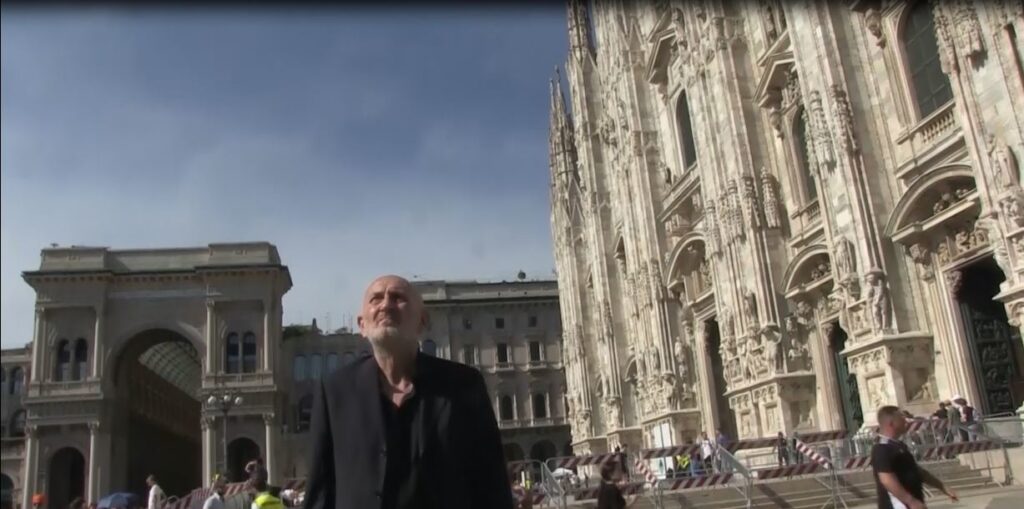
Between archive materials, literary sources and cinephile suggestions
How did you proceed with the archive materials, in particular the interviews with the authors (primarily of course Di Leo) and those clips of the press conferences with Tarantino and with the greats of genre cinema, which took place in Venice several years ago?
In addition to the subject, I wrote a screenplay in which I envisaged a series of sequences that I would then have to construct. In this sense I then moved to look for materials. Thanks to the collaboration with the Centro Sperimentale, its curator Alberto Anile and Stefano Iachetti, I obtained several industrial films from the Ivrea headquarters, which I processed and edited with the others that I had already found through in-depth historical research. The interview with Fernando Di Leo, always reworked, comes from the fundamental meeting filmed, in the mid-nineties, by Manlio Gomarasca and Davide Pulici, pioneers of the diffusion of genre cinema through the magazine Nocturno (alongside Stracult, thanks to Marco Giusti, Luca Rea and all the authors). The press conference in Venezia61, where the aforementioned Giusti and Rea created the retrospective “King of the B’s” (in which, alongside them, we find Quentin Tarantino, Joe Dante, Sergio Martino, Umberto Lenzi, the festival’s director Marco Muller), is part in my same research path as above.
How important was Davide Pulici’s contribution to the historical framework and the “reading” of the film itself?
Davide Pulici‘s contribution was fundamental and necessary. No one better than him could have critically and historically elaborated the genesis of the film, giving magnificent ideas to the narrative, from which the phrase entitled “Le ore del destino” (the Hours of destiny) was also born. The difference between the film distributed in theaters in 1972, I mean the commercial copy, compared to the original Milano calibro 9′s print, which is deposited in the Cineteca Nazionale next to the original negatives and the original audio soundtrack (main source used for digital restoration), it had engraved with a constant rhythm, the day and hours remaining until the appointment with one’s destiny. The film, from an existential point of view, is in short, through the story of a presumed invincibility, the representation of destiny and its inevitability.
Among the tutelary deities of the film there are also, obviously, Melville’s cinema and Scerbanenco’s novels. How do you stand in relation to them?
I naturally put myself in a positive way. To describe the foundations from which Milano calibro 9 was born, but in general in all works that intend to delve deeper into a historical topic, it was necessary to resort to both Jean Pierre Melville and Giorgio Scerbanenco. A very passionate reader of twentieth-century French noir literature (which, in terms of content, is similar to Gide‘s anti-moralism and Voltaire‘s philosophical thought), Fernando Di Leo clearly appears to be inspired by Le samourai, a 1967 film by Melville. In some ways, apart from the structural form of the film and parts of the plot, even the vision functional to the story of the figure of the ‘criminal’ appears similar in the two, as a tool for narrating psychological and environmental discomfort. If the ‘nocturnal’ visual atmospheres, close to Melville’s universe, it is probably Scerbanenco’s literary knowledge, however, that determines a certain type of character and narrative structure, more linked to the Milanese underworld environments of the 1960s. Di Leo reworks the writer’s “I racconti della mala“, brings those characters to life, outlining a complex and multifaceted filmic panorama.
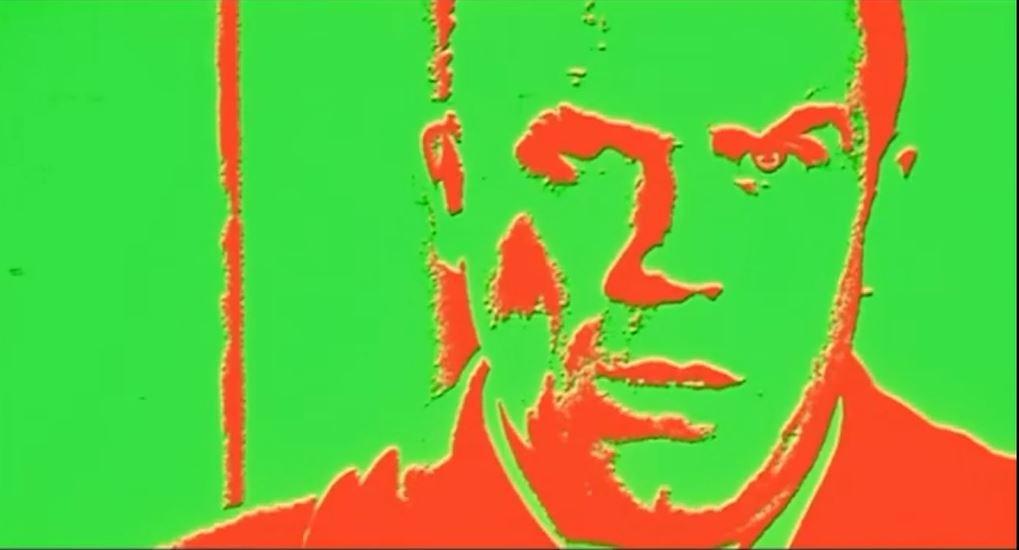
Focus on Music
More than a question, a statement: Osanna! From the wonderful Osannaples to this other documentary, their presence on stage is confirmed as essential, not only for the testimonies regarding the contribution offered to the soundtrack of Milano Calibro 9, but also for those very creative scenes shot specifically with them. What can you tell us about it?
Thank you! The Osannaples adventure, which began in December 2017 (with interviews with David Jackson of Van Der Graaf Generator and David Cross of King Crimson at the Rock Museum in Catanzaro… I’d say a good starting point), actually never ended: its stages (among others, from the premiere at the Seeyousound Film Festival, to Los Angeles-Italy, to the presentation tour of Osanna50, to the awards won), are in progress (after all, a film is for life) and also Milano calibro 9: Le ore del destino, comes in the wake of my close collaboration with Osanna. In reality, the idea for the documentary started right from their scenes: I imagined the band, made up and dressed as I designed in Osannaples (since then they have adopted those costumes in non-plainclothes concerts), interpreting the soundtrack of Milano calibro 9, within locations ideally similar to those of the “Dileian” movie, on which I made cartoon characters of gangsters move, as ironic metaphors of the genre’s imagery, alternating them at times with the real characters of the film. The power of the image and music of Osanna, the exuberant vocality of the founder and leader Lino Vairetti, has created a piano alternating with that more closely linked to the documentary, which strengthens and relaxes the vision. The hybridization of genres in an experimental key, like the very matrix of my cinematographic training, is an aspect that I believe distinguishes all of my production.
More generally, what fascinates you about the soundtrack of “Milano calibro 9” and the way Bacalov worked on it?
The soundtrack of Milano calibro 9, needless to say, I believe it to be one of the greatest masterpieces at an international level on various fronts: both in terms of the universe of soundtracks and, as a milestone, alongside Palepoli of hard-rock music psychedelic. Talking only about progressive rock is perhaps too generic in relation to a band (which I considered to be English, like Deep Purple and Led Zeppelin), whose albums from 1971 to 1974 developed unique sounds in the Italian musical panorama, still today avant-garde. Bacalov, as he himself said, had the intuition of combining ‘cultured music’, classical-symphonic music, with rock music. After having made the first operation with the New Trolls for Concerto Grosso (music score of La vittima designata), he identified Osanna as possible composers and performers of the rock part of Milan calibro 9. The union of the parts is history. I am fascinated by the sudden change of registers, from which a unique and very powerful ambient sound was created, thanks to the sound of Vairetti‘s ARP 2600 synth, Danilo Rustici‘s Hendrix-like distorted guitar, like Elio D’Anna‘s wind instruments, the power and precision of the rhythmic department of Massimo Guarino and Lello Brandi. Curiosity: for the love scene between Ugo Piazza and Nelly Bordon (Gastone Moschin and Barbara Bouchet), the wonderful ballad “There will be time”/ “Canzona” was foreseen, written specifically by Bacalov on the vocals of Lino Vairetti who, for For reasons of time, given the imminent release of the film, it was not included in the scene, but subsequently only appeared on the Osanna album.
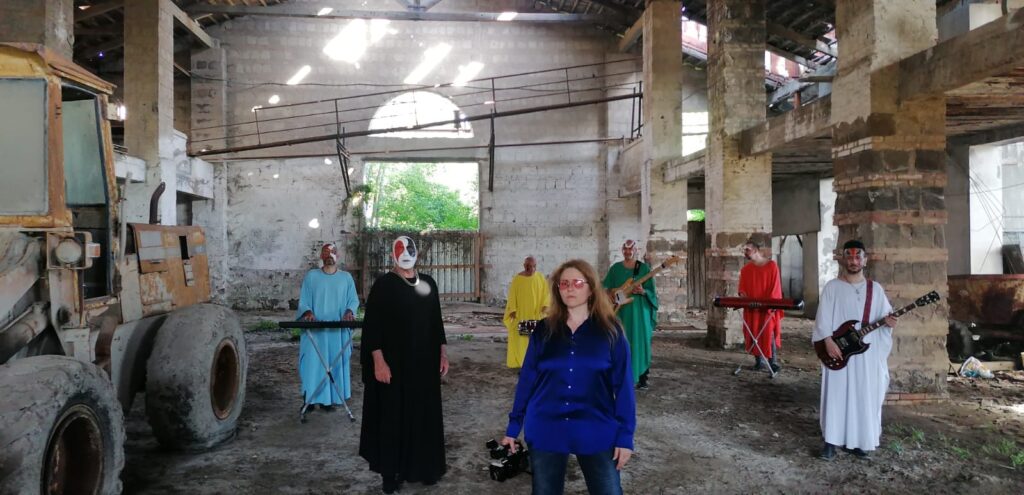
Indie movies as “mission”
In some parts of the film the discussion emerges almost forcefully, in any case in your documentary there is a crazy study of editing, pressing and very effective even (indeed, even more so) when materials from different origins alternate on the screen. How much effort and time does such painstaking work cost?
Editing is for me the most important moment of the film’s architectural construction. A phase comparable to writing and directing. In fact, no one can access and view this phase which is a private matter between me and my material. In this sense it is definitely true that it is there that my authoritarian character and therefore the arrogance of my speech emerges. Coming from artistic and architectural studies and also being a figurative artist, for me editing is the planning phase like a painting or an exempla, in which I draw and color, experiment, create images from sources that I rework, scratch, augment. On Milano calibro 9: Le ore del destino (which then received the VESPERTILIO AWARD 2023 for Best Documentary), I had the intuition of super 8, shot like a telecine, thanks to Mauro Coscia‘s film. For example, making my shots from Super 8 with those from 35 mm seamlessly combined required a lot of attention. To achieve this sophistication and the development of many other graphic creations requires infinite work, the amount of time which is always dictated by the film, by its time.
Last year you were President of the Jury at the Indiecinema Film Festival, you created yourself a festival linked to genre cinema, you know how to complete ambitious works while relying on medium-small productions and you know several other colleagues who operate in similar conditions . What does that challenge, tough to say the least, inherent in making independent cinema in Italy represent for you?
Yes, it was a wonderful experience to be President of the Jury of the Indiecinema Film Festival, alongside excellent professionals and with many beautiful films that I was able to watch. It’s true, I have created various realities around genre cinema. At the Venice Film Festival, in collaboration with the Altroquando bookshop in Rome, I created and directed the “Venezia Pulp” meetings, with several prizes and many illustrious people who participated (from Tinto Brass to Pasquale Squitieri, from the cast of Stracult to Beat Record; from Alessandro Alessandroni‘s concert to meetings on film criticism). I then conceived and directed the festival-exhibition “Le Giornate del Cinema di Genere“, with the “Premio per la musica da film Piero Umiliani“, which reached its fifth edition this year. As far as producing audiovisual works in the world of independent cinema is concerned, I believe it is a type of career like any other; it is a cultural and underground world that requires much more than official cinema, sponsored by public money, enormous preparation in every area, from in-depth knowledge of the medium and of cinematographic writing, to the management of the set and the actors, to that of production and communication processes. So, in this sense, it is a very difficult career, but I think it is much more creative and artistic than pre-packaging products for the masses based on standardized formats. It all depends on your goals and self-knowledge, what you are capable of or not. My challenge is always ongoing: I continue to be on the road and play my game.
PS: For some shots in the service we thank the photographer Riccardo Piccirillo!
